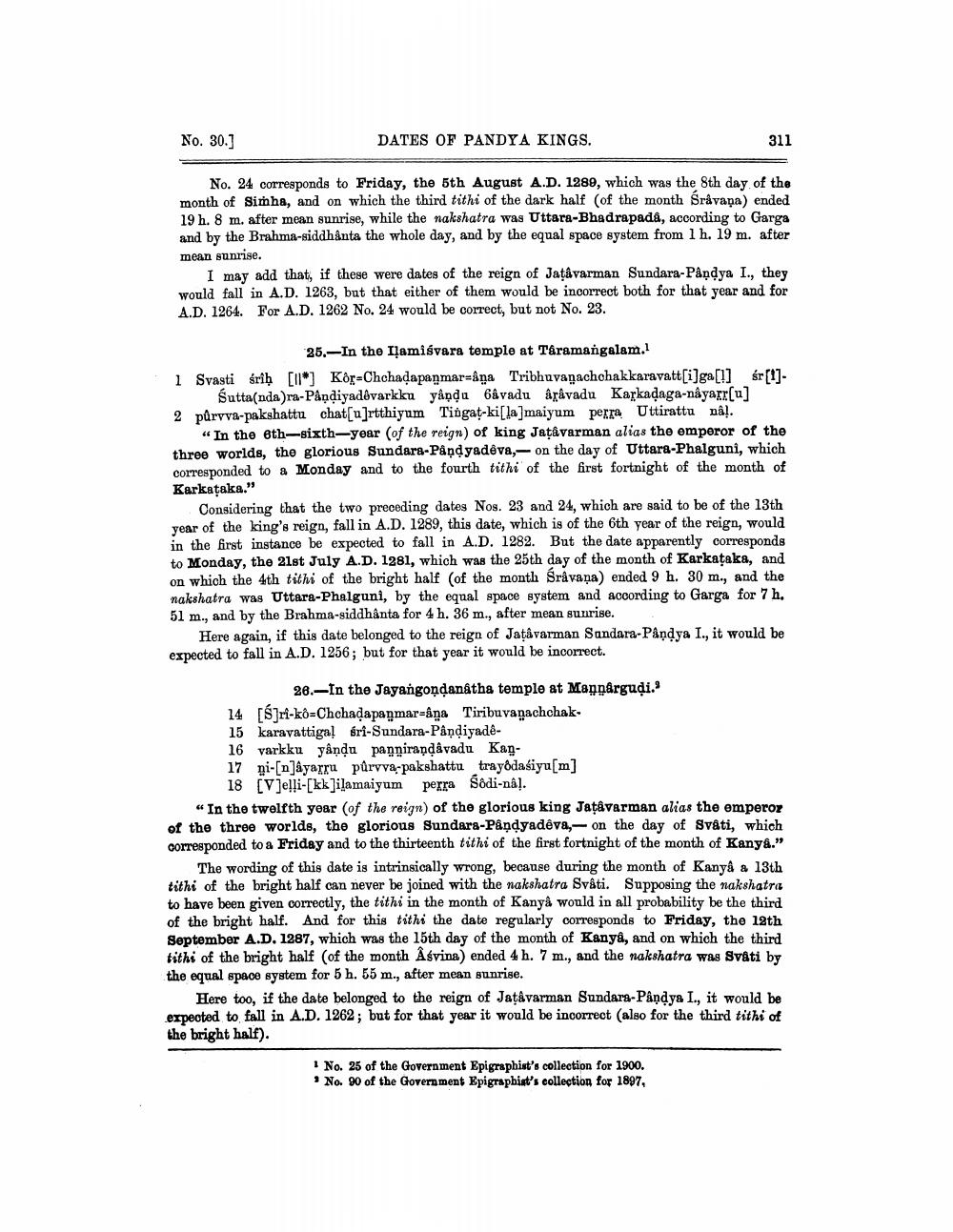________________
No. 30.]
DATES OF PANDYA KINGS.
311
No. 24 corresponds to Friday, the 5th August A.D. 1289, which was the 8th day of the month of Simha, and on which the third tithi of the dark half of the month Sråvaņa) ended 19 h. 8 m. after mean sunrise, while the nakshatra was Uttara-Bhadrapada, according to Garga and by the Brahma-siddhanta the whole day, and by the equal space system from 1 h. 19 m. after mean sunrise.
I may add that, if these were dates of the reign of Jatavarman Sundara-Pandya I., they would fall in A.D. 1263, but that either of them would be incorrect both for that year and for A.D. 1264. For A.D. 1262 No. 24 would be correct, but not No. 23.
25.- In the Iļamisvara temple at Taramangalam. 1 Svasti srih [11] Kor-Chchadapanmar=aņa Tribhuvagachchakkaravatt[i]ga[1] śr[1]
Sutta(nda)ra-Påņdiyadóvarkku yându 6âvadu ärávadu Karkadaga-nayarr[u] 2 půryva-pakshattu chat[u]rtthiyum Tingat-ki[la]maiyum perra Uttirattu na!.
"In the eth-sixth-year (of the reign) of king Jaţåvarman alias the emperor of the three worlds, the glorious Sundara-Paņdyadêva, - on the day of Uttara-Phalguni, which corresponded to a Monday and to the fourth tithi of the first fortnight of the month of Karkataka."
Considering that the two preceding dates Nos. 23 and 24, which are said to be of the 13th year of the king's reign, fall in A.D. 1289, this date, which is of the 6th year of the reign, would in the first instance be expected to fall in A.D. 1282. But the date apparently corresponds to Monday, the 21st July A.D. 1281, which was the 25th day of the month of Karkataka, and on which the 4th tithi of the bright half of the month Sravana) ended 9 h. 30 m., and the nakshatra was Uttara-Phalguni, by the equal space system and according to Garga for 7 h. 51 m., and by the Brahma-siddhanta for 4 h. 36 m., after mean sunrise.
Here again, if this date belonged to the reign of Jatavarman Sandara-Pandya I., it would be expected to fall in A.D. 1256; but for that year it would be incorrect.
26.-In the Jayangondanátha temple at Mannarguļi." 14 [s]ri-ko-Chohadapaņmar=ana Tiribuva achchak. 15 karavattiga! éri-Sundara-Pândiyade16 varkku yându panniraņdavadu Kan17 yi-[n]ậyarru purvva-pakshattu trayodasiyu[m]
18 [V]eļļi-[kk]ilamaiyum perra Sodi-nâļ. “In the twelfth year of the reign) of the glorious king Jatavarman alias the emperor of the three worlds, the glorious Sundara-Pândyadêva, - on the day of Svati, which corresponded to a Friday and to the thirteenth tithi of the first fortnight of the month of Kanya."
The wording of this date is intrinsically wrong, because during the month of Kanya a 13th tithi of the bright half can never be joined with the nakshatra Svati. Supposing the nakshatrit to have been given correctly, the tithi in the month of Kanyå would in all probability be the third of the bright half. And for this tithi the date regularly corresponds to Friday, the 12th September A.D. 1287, which was the 15th day of the month of Kanya, and on which the third tithi of the bright half (of the month Äśvina) ended 4 h. 7 m., and the nakshatra was Svati by the equal space system for 5 h. 55 m., after mean sunrise.
Here too, if the date belonged to the reign of Jaţåvarman Sundara-Påndya I., it would be expected to fall in A.D. 1262; but for that year it would be incorrect (also for the third tithi of the bright half).
1 No. 25 of the Government Epigraphist's collection for 1900. * No. 90 of the Government Epigraphist's collection for 1897,




